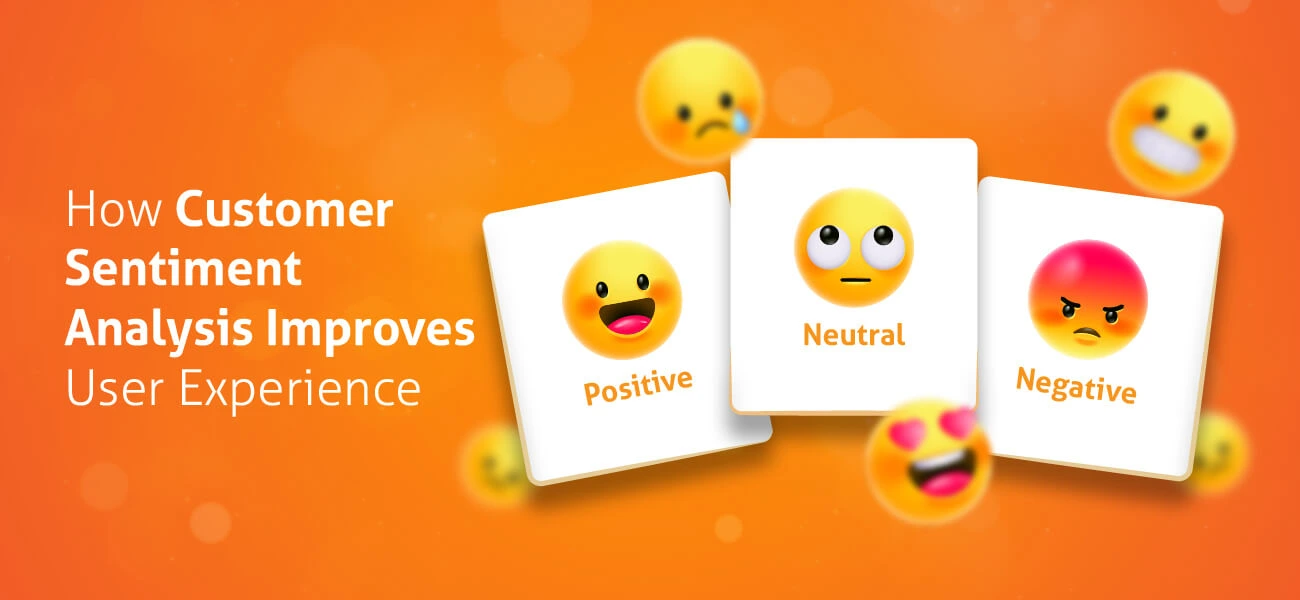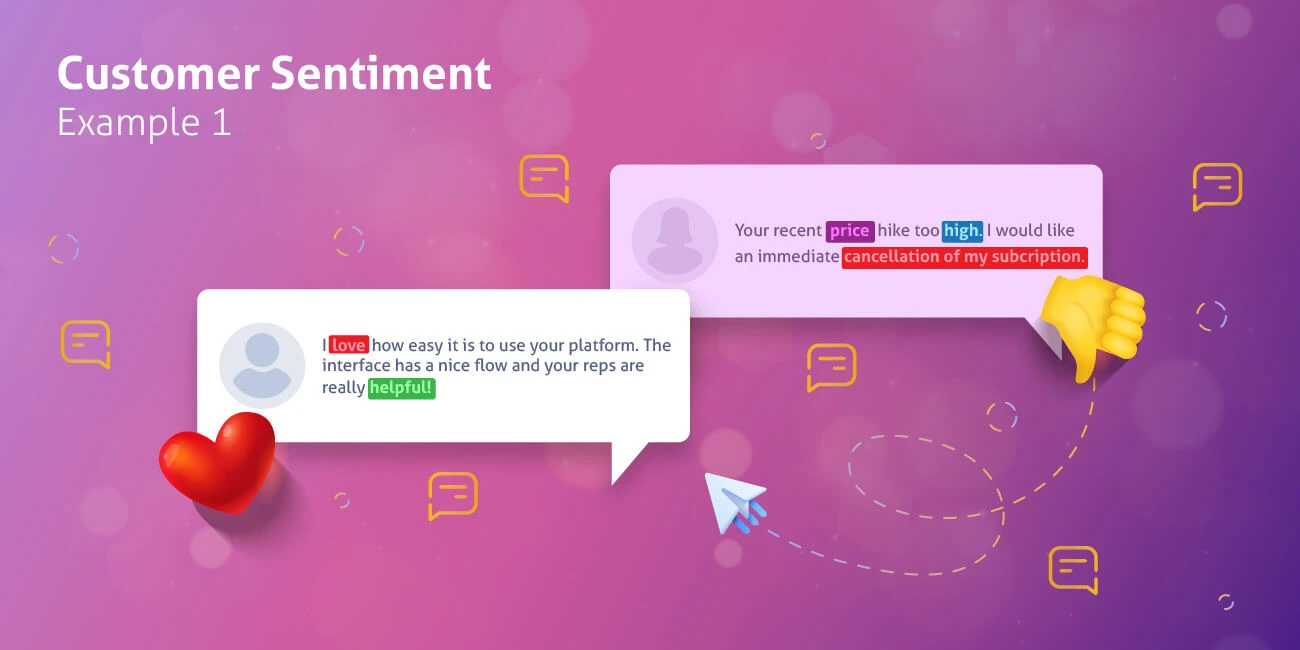A business must know if its customers are satisfied with their services and products. But, it’s almost pointless if collected after everything is over. So, the question is, “How do you get real-time information about a customer’s feelings regarding your product or service?” The answer, of course, is customer sentiment analysis.
Customer sentiment analysis, as a concept, originally came about in the 1950s. However, the process has changed over the years and now uses artificial intelligence (AI) and machine learning to sort through and analyze. So now, you get more accurate results, making it more popular in customer experience (CX).
Let’s learn a little more about:
- The meaning of customer sentiment analysis
- Its relevance to business
- Its difference from customer satisfaction, and
- How to use it to improve customer satisfaction?

What is customer sentiment analysis, and how relevant is it for businesses?
Before we learn about the analysis portion, let’s first look at the meaning of customer sentiment.
What is customer sentiment?
Customer sentiment is a customer’s opinion about a company and its service, product, or customer interactions. You can deduce if a customer has positive, negative, or neutral emotions towards your brand by tracking and analyzing their online interactions.
What is customer sentiment analysis?
Customer sentiment analysis is where a customer’s feelings about a company are ascertained and analyzed. That is why this process is also known as opinion mining.

Opinions are gathered from text available in tweets, blogs, social media, news, reviews, and more. Then, NLP, statistics, and machine learning methods are used to analyze the data.
The algorithms that process the text data and analyze customer sentiment use two criteria: the polarity of the opinion and the magnitude of the emotion. The polarity indicates whether a customer’s opinion is positive or negative. Magnitude depicts the intensity of the emotion behind the opinion.
How is it relevant to businesses?
Customer sentiment is even more relevant now, as most consumers’ customer service standards have increased.
Moreover, customers today can easily express their good or bad opinions to the rest of the world on social media. Unfortunately, most people are quick to complain or post negative sentiments and reviews and slow to appreciate or post positive reviews.
To make things worse, one negative post can provoke other customers into posting similar comments if they relate to the experience. It can damage a brand’s image.
When you use customer sentiment analysis, you can expect it to:
- Give meaningful insights into customer interactions, satisfaction levels, loyalty, and preferences.
- Track brand mentions and the online reputation of your business.
- Help better product quality, pricing, and marketing efforts.
- Help boost customer loyalty, satisfaction, and retention.
- Help customize messages and offers.
- Spot promoters to boost referrals and word-of-mouth.
- Speed up resolution of customer issues.
Is customer sentiment the same as customer satisfaction?
No. Customer sentiment is not the same as customer satisfaction. Customer sentiment measures the customer’s opinion or perception of your brand or image. Customer satisfaction measures whether or not a customer is satisfied with your products, services, support, etc.
Satisfaction levels can influence customer sentiment, but not the other way around. It is also measured after they have used your product, service, or support. In comparison, sentiment is measured in real-time and focuses on how a customer feels at a particular moment.
Customer satisfaction is usually measured on numbered or graded scales (0 to 5, or strongly disagree to strongly agree). But customer sentiment is measured by analyzing text data from various sources.
Tips to improve customer satisfaction with in-depth sentiment analysis
Many customers don’t fill out customer satisfaction surveys, leaving companies with a small sample size to work with. Moreover, customer satisfaction surveys cannot pick up on all the customer’s emotions. This is mainly because the questionnaires are usually prepared by the company.
The same issues don’t occur with sentiment analysis, as you are not using questionnaires to gather the customer’s opinions. Conversely, you are gauging their opinions based on online posts and comments.
Here are some tips to improve customer satisfaction using sentiment analysis:
1. Implement customer sentiment analysis at contact centers for product improvements
Use sentiment analysis at your contact centers to measure customer satisfaction as they speak to call agents. It’ll aid in getting you the data needed to improve products, services, customer interactions, etc.
2. Use AI-driven sentiment analysis tools to monitor customer opinion
Today, you will find many AI-driven software that can perform customer sentiment analysis. They use AI to recognize emotions expressed by consumers in text form on social media, product review platforms, customer support emails, etc.
AI helps the analysis tool screen large volumes of text data, categorize customers’ opinions as negative or positive, and assign scores based on the intensity of the emotion (known as customer sentiment scores).
These tools can help monitor customer sentiment, understand customer needs, and make informed decisions to improve user satisfaction.
3. Identify customers who need extra attention
Customer sentiment analysis can reveal to you how a customer truly feels about your brand. Use this information to identify consumers that are most in need of your attention, like customers who are struggling to pay for the product.
You can also identify customers who are irritated with the customer support staff or those who are about to end their customer relationship. After identifying these ‘problem customers’, plan ways to improve their experience and satisfaction.
Sentiment analysis data can also help you pick consumers with the prospect of being brand promoters. They are mostly customers who openly express their opinions and share their positive experiences with your brand and products or services.
4. Create personalized experiences
You can get plenty of understanding about the intention behind a customer’s comment, review, or post. Hence the term intent-based sentiment analysis. Using AI and ML, the software can determine whether the text is a complaint, query, command, or desire.
Once you understand why the customer wrote the text, you can take the appropriate steps. For example, preparing FAQs, to answer common questions your consumers might have. Or you can develop plans to compensate customers who have had a negative experience.
5. Identify problem areas
When conducting this analysis, there will be times when you come across problem areas in particular departments, products, or support services.
For example, call center sentiment analysis can help screen through feedback and agent-customer interactions to measure the different emotions, attitudes, and opinions. It’ll check phone calls and chats for positive or negative words for an understanding of how the customer-agent interactions are going.
If the customer has a negative opinion of their interactions with call agents or customer service reps, you can use their suggestions to prepare a training program. It’ll make interactions and customer experience better.
6. Research your competitor’s customer sentiment and avoid the same mistakes
The wise learn from others’ mistakes and avoid them. Apply the same principle to your business. Observe your competitors to learn what they’re doing right or wrong and avoid the same mistakes. You can learn all this by studying their customer sentiment.
If you’re already making similar mistakes, take proactive steps to correct yourself before it is too late. Customers appreciate it when brands correct their mistakes on their own rather than committing the same errors till someone notices.
7. Identify and reward good customer support agents
Happy employees mean happy customers. And the best way to keep your employees happy is to recognize their efforts and reward them. Use sentiment analysis to spot employees that impress your customers.
Reward such employees through various award schemes, like “employee of the month”. You can also reward them with coupons or paid trips for a destination vacation!
8. Respond to positive and negative opinions
Many companies don’t respond to online comments, regardless of whether they are positive or negative, but especially if they are bad. This is a mistake, as ignoring such comments doesn’t make them disappear. Instead, doing so can give the impression that you don’t care or that you are being aloof.
Responding to online comments might not seem worth your time, but it means a lot to your customers. It makes them feel like you care and are open to conversation. Remember that online posts and comments are a form of customer feedback. Engage with these customers and reply to their reviews or complaints online.
If the comments are negative, thank them for their feedback and assure them that you will resolve their issues. If the comments are positive, thank them for their compliments and kind words. Not many customers bother posting positive reviews unless you remind them. So, take the time to reply to those who have put in the effort to do so. Replying to positive comments can sometimes encourage others to also leave an honest review.
How do you measure customer sentiment?
Some popular methods of measuring customer sentiment are NPS and CSAT surveys. NPS surveys measure customer experience sentiment based mostly on how likely they are to recommend a company to others. Meanwhile, CSAT asks customers to rate their satisfaction based on different interactions with the company, say after a call with customer support.
Coming to an end…
Sentiment analysis makes understanding how customers feel easy. And the rise of NLP and machine learning has even made it possible to measure sentiment in real time.
Some tools can even categorize sentiments and give them values to show severity. Make the best use of this technology to get ahead of the competition.


